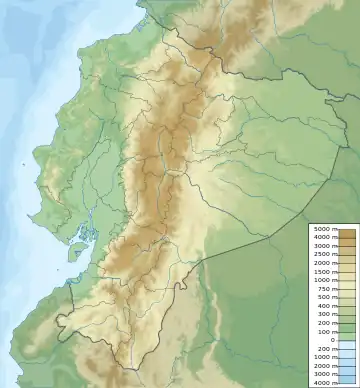| Atelopus onorei | |
|---|---|
| Scientific classification | |
| Domain: | Eukaryota |
| Kingdom: | Animalia |
| Phylum: | Chordata |
| Class: | Amphibia |
| Order: | Anura |
| Family: | Bufonidae |
| Genus: | Atelopus |
| Species: | A. onorei |
| Binomial name | |
| Atelopus onorei Coloma, Lötters, Duellman, and Miranda-Leiva, 2007[2] | |
 | |
| Atelopus onorei is only known from its type locality in the Azuay Province. | |
Atelopus onorei is a small species of bright yellow and green toads in the family Bufonidae.[3][4] It is endemic to Ecuador and is only known from the vicinity of its type locality on the western slope of the Cordillera Occidental in the Azuay Province.[1][3][4] It has not been seen since 1990 and may now be extinct, but it is possible that overlooked populations remain.[1][2][4]
Etymology
The specific name petersi honors Giovanni Onore, an Italian missionary priest and entomologist[5] who has also made significant amphibian collections.[2] Common name Onore's harlequin frog has been coined for it.[4]
Description
Adult males measure 34–42 mm (1.3–1.7 in) and adult females 42–48 mm (1.7–1.9 in) in snout–vent length. The snout is acuminate. The tympanic membrane is absent. The fingers have no lateral fringes nor webbing whereas the toes are webbed. The dorsum and the limbs are orange yellow with varying degrees of green coverage (covering all but the extremities in one male), or occasionally pale yellowish brown with diffuse black blotches. The iris is aqua blue, with fine black reticulation and a fine bluish-white stripe at the upper margin of pupil.[2]
Habitat and conservation
Atelopus onorei was found in 1990 in cloud forest at the margin of the Río Chipla at an elevation of about 2,500 m (8,200 ft) above sea level and by a nearby creek. The individuals were active at the daytime and numerous pairs were in amplexus.[1][2]
Atelopus onorei has never been seen again, despite several visits to the same site and its surroundings.[1][2] The disappearance is attributed to the disease chytridiomycosis. Current threats are predation by trout and cattle grazing. If the species is not yet extinct, the remaining population is likely to be very small.[1]
References
- 1 2 3 4 5 6 IUCN SSC Amphibian Specialist Group (2018). "Atelopus onorei". IUCN Red List of Threatened Species. 2018: e.T136173A98658156. doi:10.2305/IUCN.UK.2018-1.RLTS.T136173A98658156.en. Retrieved 20 November 2021.
- 1 2 3 4 5 6 Coloma, Luis A.; Lötters, Stefan; Duellman, William E. & Miranda-Leiva, Alfonso (2007). "A taxonomic revision of Atelopus pachydermus, and description of two new (extinct?) species of Atelopus from Ecuador (Anura: Bufonidae)". Zootaxa. 1557 (1): 1–32. doi:10.11646/zootaxa.1557.1.1.
- 1 2 Frost, Darrel R. (2018). "Atelopus onorei Coloma, Lötters, Duellman, and Miranda-Leiva, 2007". Amphibian Species of the World: an Online Reference. Version 6.0. American Museum of Natural History. Retrieved 4 November 2018.
- 1 2 3 4 Coloma, L. A.; et al. (2018). Ron, S. R.; Merino-Viteri, A. & Ortiz, D. A. (eds.). "Atelopus onorei". Anfibios del Ecuador. Version 2018.0. Museo de Zoología, Pontificia Universidad Católica del Ecuador (QCAZ). Retrieved 4 November 2018.
- ↑ Beolens, Bo; Watkins, Michael & Grayson, Michael (2013). The Eponym Dictionary of Amphibians. Pelagic Publishing. p. 158. ISBN 978-1-907807-42-8.
